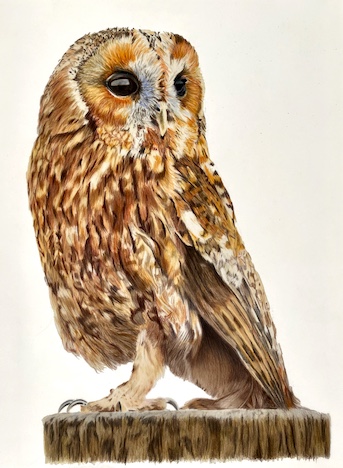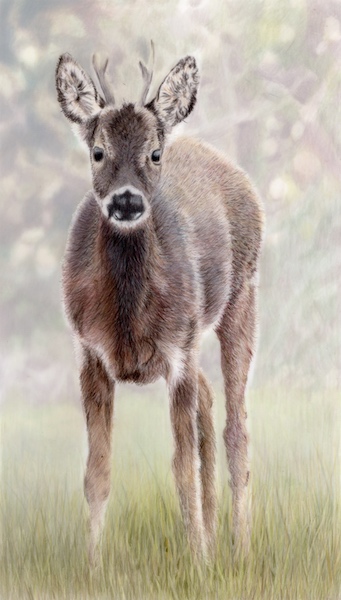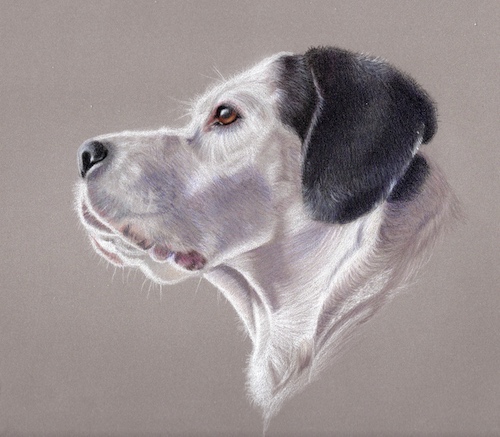- Home
- Drawing Papers
How to Choose the Right Drawing Paper for Coloured Pencil Artwork
Let's look at the different drawing papers and surfaces available to coloured pencil artists.
The surface used to complete your art work makes a vast difference to the result.
Papers that are too smooth will not pick up enough pigment from your coloured pencil, and you will find they don't accept enough layers for you to achieve the colour strength you require.
Papers that are too rough, will pick up lots of colour but give no accuracy of line or detail.
Special surfaces made for pencil work can produce superb results - at a cost! But is the extra investment worth it?
Let's start by considering paper - the most common surface that pencil artists use.
- What is paper?
- Why do different papers have different surfaces?
- How do you stretch paper to stop it buckling when you use water based media?
- How do you remove a dent from paper?
We did a series of pencil tests on 15 different papers suitable for coloured pencil work, check out the results on this page.
We also investigated the best paper for coloured pencil by drawing the same subject on 8 different surfaces, using the same selection of pencils.
Choosing the Right Drawing Paper: Weight, Texture and Surface Types
You can buy paper in many forms, and the descriptions can confuse a new artist. Manufacturers describe quality drawing papers by weight and the type of surface.
Weight of the paper
Because we need to know how a paper is likely to perform, we need to know how thick it is and how it is likely to respond to treatment under a brush, pen or pencil.
Weight relates to the weight of a square meter of a single sheet of the paper quoted in grammes. Here are some example weights...
- Copy paper for home printers will probably be around 90gsm - too light for artwork.
- Cartridge paper could be 120gsm or even 220gsm. Good for dry media use and the heavier paper will take a fair amount of pencil work correction.
- Watercolour paper for serious use will be anything from 220gsm to 500gsm and above.
The USA and some other parts of the world still use imperial measurements. In Europe they quote the weight of paper in metric, which is much easier to explain.
By weighing five hundred sheets of paper (17 inches by 22 inches) we can calculate the thickness of each sheet.
The comparisons are not exact, but the common 300gsm watercolour paper compares with 140lb, and a 400gsm paper with 188lb. I would not recommend that you use a paper with a weight under 125gsm (approx 60lb).
Surface type and colour
Cartridge paper has a fine grain surface which works very well for graphite and purely dry media. It also works well for pen, which involves very little moisture.
Watercolour papers come in Hot Pressed, Cold Pressed or 'Not', and Rough surfaces.
You will also find papers labelled as Plate, Smooth, Vellum or Satin.
Pastel papers often have a different surface on each side, with one being smoother and the other having a distinctive lined or honeycomb texture. Because they come in a wide variety of colours, they are attractive to the coloured pencil artist, who would normally use the smoother side.
Black paper is also popular. Don't forget to check out the step-by-step tutorial which shows an indoor scene worked in pastel pencil on black paper.
Talking of coloured papers, you might like to check out the page on working coloured pencil on black paper for tips and techniques.
Presentation
Some drawing papers come in pads with one edge secured with either glue or a spiral binding so they open like a book.
Others come in blocks that are secured around all the edges so that they are pre-stretched for watercolour use. This can confuse the new artist, who cannot find a simple way to remove the top sheet. The trick is to inspect the edges of the block. Eventually you will find an area that has no seal, often a corner but sometimes along an edge. Carefully separate the top sheet using the edge of a plastic ruler or similar smooth, blunt instrument. This will avoid tearing the next sheet down, which is possible if you use a knife.
How is paper made?
Paper is a mixture of fibres mixed with water and traditionally made by hand in a mould. However, these days they are more commonly made by machine. The fibres enter the machine as a slurry mixture which is drained of as much water as possible and the resulting wet, felt like material is pressed between rollers and then dried.
If the finishing rollers are smooth and hot, the paper will be smooth and referred to as Hot Pressed.
If the rollers are cold, the paper will be Cold Pressed, or in old 'artspeak' NOT - or NOT Hot Pressed. (Who said artists don't have a sense of humour?).
Rough papers are made by pressing them between rough woven blankets or rough textured rollers at the stage where the surface is established. They are usually the heavier weight and more expensive papers, but they are less suitable for coloured pencil work so we will not get excited about them here.
The fibres in drawing paper can be cotton, wood pulp or a mixture.
- Lower cost papers often use wood pulp, buffered by chemicals to delay internal acid rot.
- Archival papers, intended to last for a long time without going yellow, contain cotton.
- More exotic drawing papers, often from the Far East, use ingredients, such as leaves or bamboo.
Internal and external sizing
Size is a gelatine like ingredient which enables you to use wet media without the paper soaking it up like a sponge. The manufacturer either adds the Size when the pulp is mixed (internally sized) or sprays it onto the hot paper as it comes off the machine, as a final coat (externally sized).
If you are certain that you will only use dry pencils, then you can use unsized paper.
Sometimes you may find that a hot pressed paper, such as Arches, will have too much Size, and coloured pencils will skate over the smooth surface. A neat trick is to wipe the paper with a damp cloth to remove some external size and raise the grain to give more tooth for the pencils to grip onto.
Cartridge paper
Using thin papers such as Cartridge (an unsized paper) is fine for dry point coloured pencil but it is advisable to still hold the paper in place on your drawing board with either pins, tape or White Tac to stop it moving about while you work. It is worthwhile checking that your board is perfectly smooth before working with a thin paper, otherwise place a sheet of smooth paper below your working sheet to smooth out any unevenness.
I also like to place a second sheet of fresh cartridge paper on top, secured at the top edge by tape or White Tac to protect my artwork while it is being transported or stored before framing.
Stretching paper for wet media
If you add water to an unsized paper, or one lighter than 300gsm (140lb), it is likely to buckle when it dries. But what can you do if that is all you have available and want to use watercolour pencils and a fair amount of water, but a smooth finished result?
We can pre-stretch the paper to prevent this from happening during the application of wet media. The page on stretching watercolour paper gives full instructions for this process.
If you stretch a sheet of paper, but don't end up using wet media, you won't harm the paper.
Drafting Film for Coloured Pencils – Pros, Cons and Best Brands

Tawny Owl by Carol Leather, created on a single sheet (worked on both sides) of Polydraw film. She laid cream paper behind the drawing for the background.

A popular drawing surface is Drafting Film, made from polyester, not paper. In appearance it resembles a thick tracing paper as it is translucent. It is very smooth but takes coloured pencil beautifully, although it reduces the number of layers you can use. However, you can also work on the back of the film or even layer multiple sheets as I did for the deer drawing above.
The weight of the film can vary, with PolyDraw being the flimsiest, DuraLar a little thicker and Grafix Drafting Film the most sturdy.
Another plastic based substrate is NeverTear 'Paper', which unlike Drafting Film is pure white and opaque. This is another ultra smooth surface which works really well with coloured pencil. It is also waterproof, which means you can use wax pencils on it when sketching outside in all weathers.
Sanded papers
 Polly, drawn by Carol, on Pastelmat
Polly, drawn by Carol, on PastelmatGoing to the other extreme, you can work on sanded substrates, such as Uart or Tim Fisher pastel paper. These have a grit surface to the paper which grips hold of pastel, or in our case coloured pencil.
Lux Archival, a sanded surface designed and manufactured by Alyona Nickelsen's company Brush and Pencil, is a white paper rather than the darker colour of the Uart, It is currently only available in the UK from Jacksons Art.
Another product designed originally for pastel artists is ClaireFontaine Pastelmat. Similar to the sanded boards, the surface of this grips hold of the pencil (or pastel) but has in fact a cellulose fibre coating. It allows for many, many layers of pencil, but it can put off some artists because of the grainy appearance as the first few layers go down.
Surprising Surfaces You Can Use for Coloured Pencils
Did you know you can also use coloured pencil on untreated wood and even dried gourds?


